Robotic Nurse Assistant Market Size
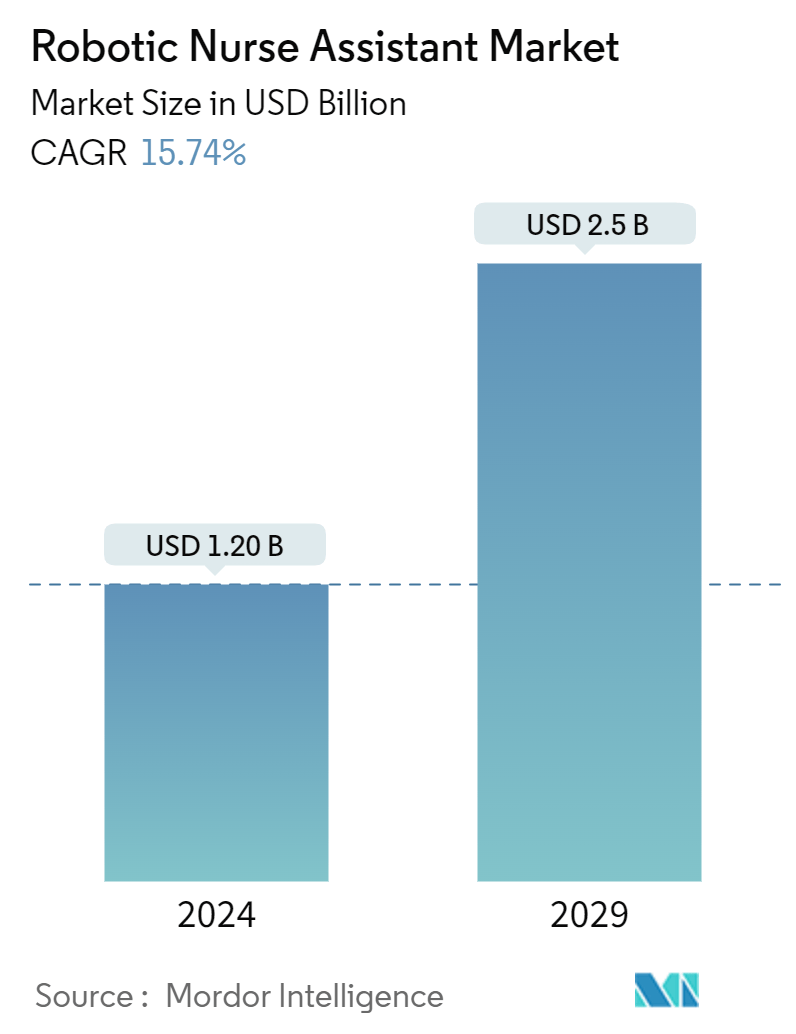
| Study Period | 2019 - 2029 |
| Market Size (2024) | USD 1.20 Billion |
| Market Size (2029) | USD 2.5 Billion |
| CAGR (2024 - 2029) | 15.74 % |
| Fastest Growing Market | Asia Pacific |
| Largest Market | North America |
Major Players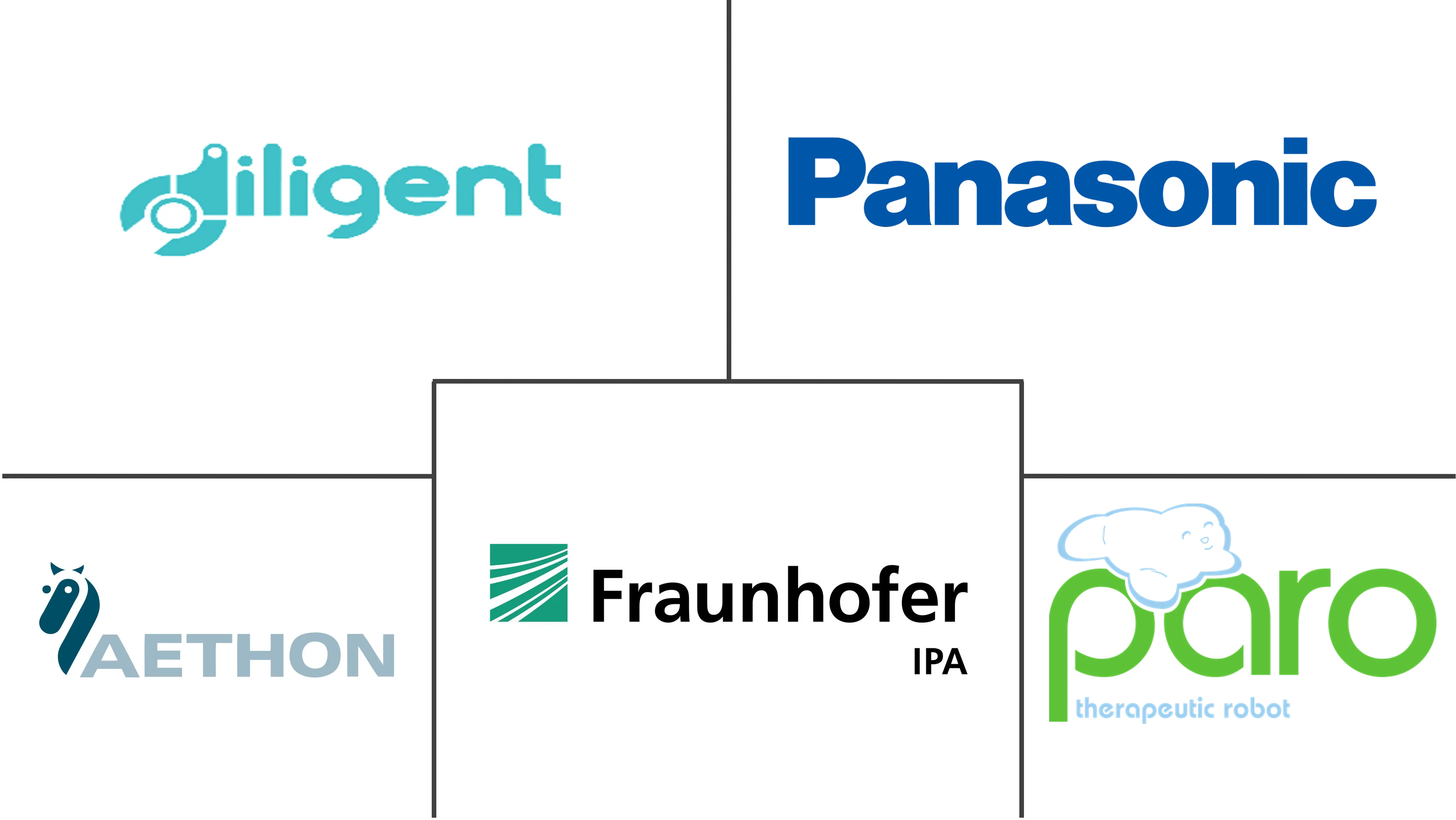
*Disclaimer: Major Players sorted in no particular order |
Robotic Nurse Assistant Market Analysis
The Robotic Nurse Assistant Market size is estimated at USD 1.20 billion in 2024, and is expected to reach USD 2.5 billion by 2029, growing at a CAGR of 15.74% during the forecast period (2024-2029).
The factors supporting the growth of the robotic nurse assistant market include a growing senior population for various daily assistance functions and a rise in funding and grants for developing technologically advanced nurse-assisting robots. For instance, according to the World Population Prospects 2022, the proportion of the global population aged 65 and older is projected to increase significantly, rising from 10% in 2022 to 16% in 2050. These projections indicate that by 2050, the worldwide number of people aged 65 years or older will be more than double that of children under five years old and roughly equivalent to the number of children under twelve. Thus, the increasing geriatric population worldwide may create the need for robot nurse assistance, which is anticipated to drive the market over the projected period.
Moreover, a rise in funding and grants for developing technologically advanced nurse-assisting robots is expected to contribute to the market's growth over the forecast period. For instance, in June 2023, pre-clinical medical device company Microbot Medical received financing worth NIS 1.62 million (USD 440,000) from the Israel Innovation Authority (IIA) for its endovascular surgical robotic system LIBERTY. The grant will help further develop the manufacturing process linked to the LIBERTY Robotic Surgical System. Similarly, in April 2022, Diligent, a company developing nurse-assisting robots, secured over USD 30 million in series B funding. This investment will empower Diligent to enhance its scalability and address supply chain challenges as it continues to roll out its nurse-assisting robot, Moxi. These investments are anticipated to contribute to the growth of the market during the forecast period.
Furthermore, research and development for the next generation of robotic nurse assistants is ongoing to improve hospital nurse care. For instance, in January 2024, researchers from the National Robotarium in Paris, France, successfully tested next-generation socially assistive robots in a hospital setting. As part of the SPRING (Socially Assistive Robots in Gerontological Healthcare) trial, these robots were used to assist patients, alleviate anxiety, and ease the workload of nursing staff. The robots, equipped with advanced artificial intelligence, could hold natural conversations, understand patient needs, and aid hospital staff with routine tasks. The trial involved three waves of experiments with elderly volunteers at Assistance Publique Hôpitaux de Paris. Such research and development activities are expected to launch a new assistant that will contribute to market growth.
Thus, the growing geriatric population, increasing funding for developing technologically advanced robotic nurse assistants, and growing research and development activities are expected to boost segment growth over the forecast period. However, the high cost of robots is expected to hinder the market's growth over the forecast period.
Robotic Nurse Assistant Market Trends
Daily Care and Transportation Robots are Expected to Witness Growth Over the Forecast Period
Daily care robotic nurse assistance helps facilitate movement in hospitals as it can aid people in their activities of daily living (ADL). Daily care and transportation are transforming work in hospitals. Autonomous mobile robots (AMRs) are equipped with navigational systems that enable them to know about the place they are at and the place further away.
The shortfall of healthcare workers in hospitals requires daily care and transportation robots. For instance, according to the data published by the Health, Labor, and Welfare Ministry in February 2023, Japan is projected to face a shortage of approximately 377,000 healthcare workers by 2026. This anticipated labor shortage is expected to drive growth in the daily care and transportation robots segment during the forecast period.
Similarly, major players in the region engaged in product launches are expected to boost the growth of the market segment. For instance, in June 2023, Touchlab, a deep-tech robotics company and resident of the National Robotarium, unveiled a groundbreaking robot that enables clinicians to experience remote tactile feedback, revolutionizing patient care. This pioneering technology, dubbed Välkky, is currently undergoing a pilot program at a Finnish hospital. Similarly, in October 2023, Lancaster General Hospital (LGH) introduced two new robotic assistants, 'Roxy' and 'Rosie,' to its nursing staff. These robots are designed to help with routine non-clinical tasks like fetching and delivering supplies, freeing up nurses to devote more time to patient care. Thus, the installation of such robotics for daily care and transportation in hospital settings is expected to contribute to the segment growth over the forecast period.
Thus, the segment is expected to grow in the future due to the growing shortage of healthcare staff and the launch of robotic nurse assistant systems in hospitals.
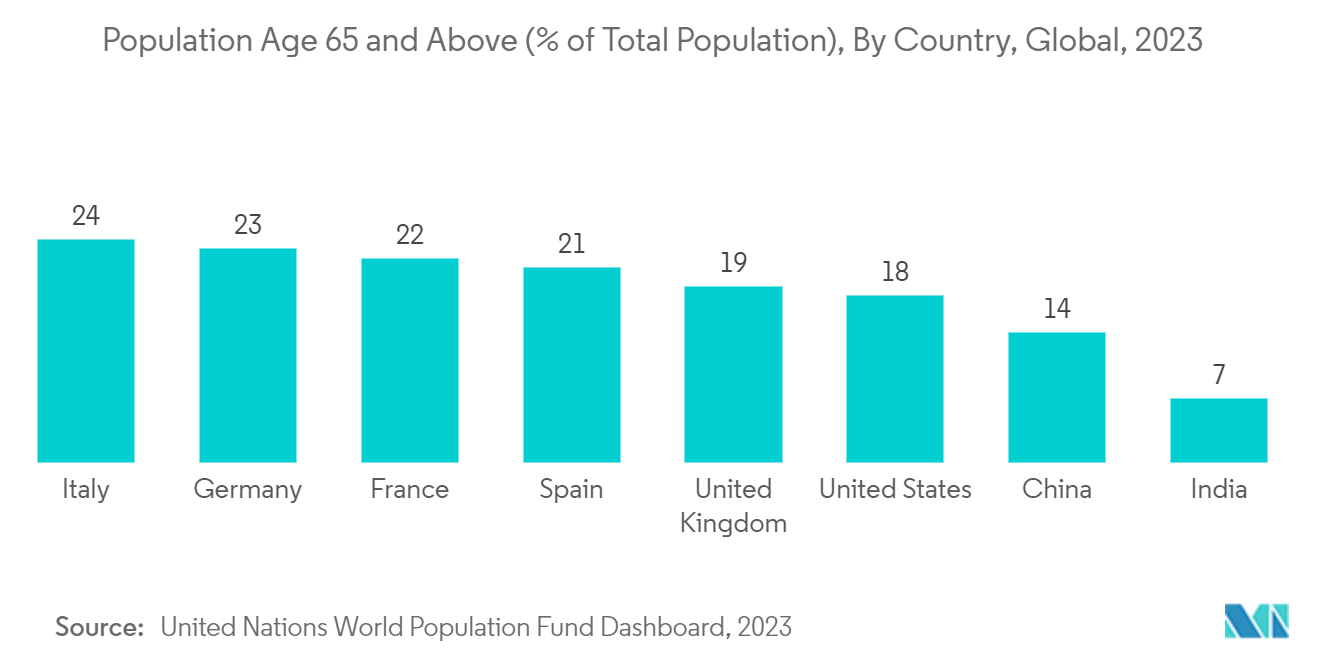
North America is Expected to Hold Significant Market Share During the Forecast Period
The robotic nurse assistant market in North America is anticipated to flourish, fueled by the availability of advanced healthcare infrastructure and substantial R&D expenditures. The demand for surgical robots is increasing in North America due to the rising number of robotic-assisted surgeries in the region. The increasing threat of chronic diseases and the higher healthcare expenditure have spurred more robust sales of such robots in the area.
The increasing prevalence of chronic diseases in North America, coupled with a rapidly aging population, is fueling the growth of the robotic nurse assistant market in the region. The data from Health Canada Statistics in October 2022 projected that seniors will comprise nearly a quarter of the population by 2040. This demographic shift and rising chronic disease rates lead to higher hospital admissions, driving the demand for robotic nurse assistants and propelling market expansion in the region.
Furthermore, several hospitals are implementing robotic nurse assistants, which is another factor boosting the growth of the market. For instance, in March 2023, the Angleton Danbury campus of the University of Texas Medical Branch welcomed two new robotic staff members. These nearly life-sized robots are designed to assist human staff, allowing nurses to spend more time with patients by taking on specific tasks.
Moreover, several funding initiatives that support the development of robotic nurse assistants are expected to contribute to market growth. For instance, in April 2022, Diligent Robotics closed over USD 30 million in a series B funding, bringing the total investment raised to date to nearly USD 50 million. The funds raised during this round will help Diligent optimize the supply chain and design teams for faster robot deployment.
Thus, due to the growing number of hospital admissions and the increasing prevalence of chronic diseases, the market is expected to witness considerable growth during the forecast period.
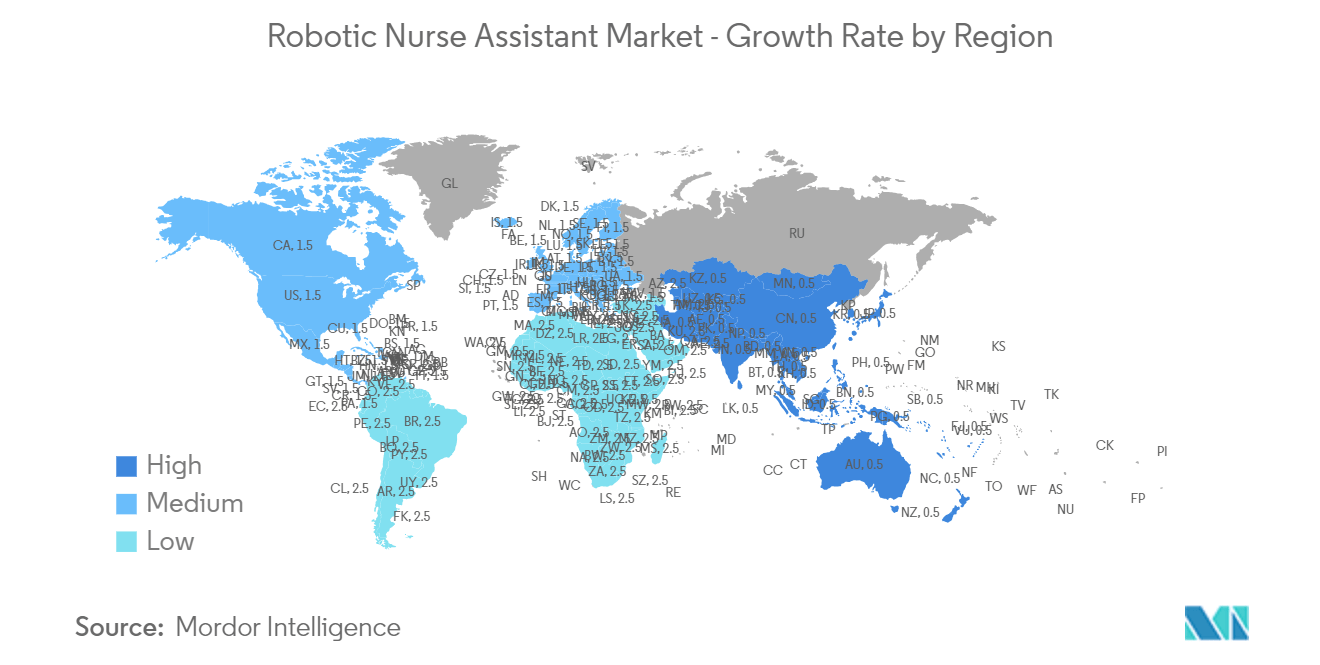
Robotic Nurse Assistant Industry Overview
The robotic nurse assistant market is moderately consolidated. Increased innovation and a rise in investment for various public and private organizations are expected to intensify industry rivalry across the world. They are also collaborating with other players to develop and promote their products in the market. The major players in the market include Diligent Robotics, Panasonic, Fraunhofer IPA, Aethon, and PARO Robots US Inc.
Robotic Nurse Assistant Market Leaders
-
Diligent Robotics
-
Panasonic
-
Fraunhofer IPA
-
Aethon
-
PARO Robots U.S., Inc.
*Disclaimer: Major Players sorted in no particular order
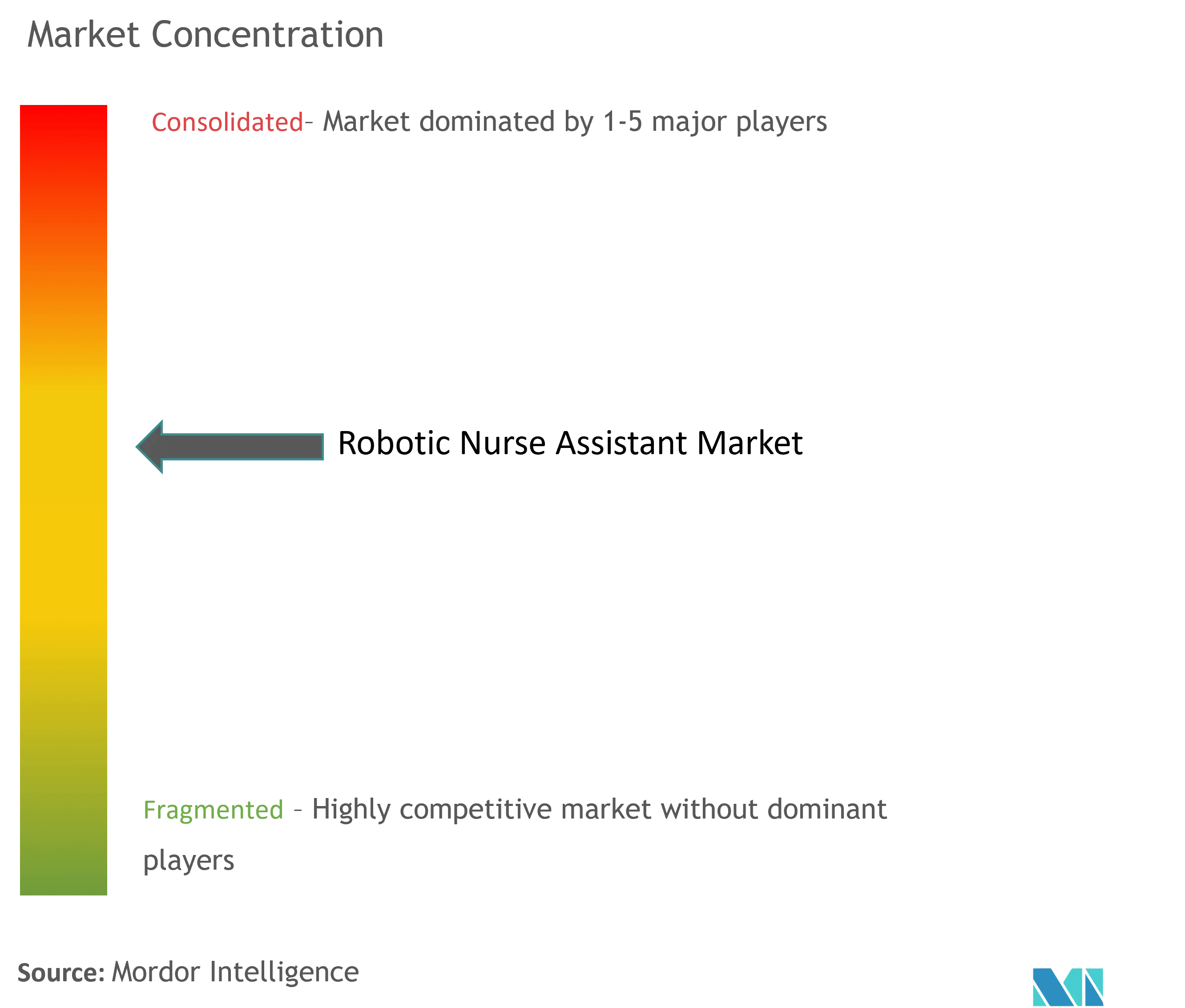
Robotic Nurse Assistant Market News
- September 2023: Saint Luke introduced a pilot program featuring Moxi, a delivery robot. Moxi helps streamline operations by fetching medications, supplies, and other necessities, freeing up to 30% of clinical staff time. This company aims to support staff and allow nurses to dedicate more time to patient care.
- January 2023: Aeolus Robotics introduced aeo, a dual-arm humanoid robot that aids in a variety of service tasks, including delivery, security, eldercare, kiosk operation, and ultraviolet germicidal disinfection. The company's hands-on approach to service, operated by aeo, combines unique mobility with advanced functionality to perform tasks such as opening doors, picking up objects, and riding elevators.
Robotic Nurse Assistant Market Report - Table of Contents
1. INTRODUCTION
- 1.1 Study Assumptions and Market Definition
- 1.2 Scope of the Study
2. RESEARCH METHODOLOGY
3. EXECUTIVE SUMMARY
4. MARKET DYNAMICS
- 4.1 Market Overview
-
4.2 Market Drivers
- 4.2.1 Growing Geriatric Population
- 4.2.2 Rise in Funding and Grants for the Development of Technologically Advanced Nurse-assisting Robots
-
4.3 Market Restraints
- 4.3.1 High Cost Associated With Robots
-
4.4 Porter's Five Forces Analysis
- 4.4.1 Threat of New Entrants
- 4.4.2 Bargaining Power of Buyers/Consumers
- 4.4.3 Bargaining Power of Suppliers
- 4.4.4 Threat of Substitute Products
- 4.4.5 Intensity of Competitive Rivalry
5. MARKET SEGMENTATION (Market Size by Value - USD)
-
5.1 By Product Type
- 5.1.1 Independence Support Robots
- 5.1.2 Daily Care and Transportation Robots
- 5.1.3 Other Product Types
-
5.2 By End User
- 5.2.1 Hospitals and Clinics
- 5.2.2 Senior Care Facilities
- 5.2.3 Homecare Settings
- 5.2.4 Other End Users
-
5.3 Geography
- 5.3.1 North America
- 5.3.1.1 United States
- 5.3.1.2 Canada
- 5.3.1.3 Mexico
- 5.3.2 Europe
- 5.3.2.1 Germany
- 5.3.2.2 United Kingdom
- 5.3.2.3 France
- 5.3.2.4 Italy
- 5.3.2.5 Spain
- 5.3.2.6 Rest of Europe
- 5.3.3 Asia-Pacific
- 5.3.3.1 China
- 5.3.3.2 Japan
- 5.3.3.3 India
- 5.3.3.4 Australia
- 5.3.3.5 South Korea
- 5.3.3.6 Rest of Asia-Pacific
- 5.3.4 Middle East and Africa
- 5.3.4.1 GCC
- 5.3.4.2 South Africa
- 5.3.4.3 Rest of Middle East and Africa
- 5.3.5 South America
- 5.3.5.1 Brazil
- 5.3.5.2 Argentina
- 5.3.5.3 Rest of South America
6. COMPETITIVE LANDSCAPE
-
6.1 Company Profiles
- 6.1.1 Diligent Robotics
- 6.1.2 Panasonic
- 6.1.3 Fraunhofer IPA
- 6.1.4 Aethon
- 6.1.5 PARO Robots US Inc.
- 6.1.6 Travelmate Robotics
- 6.1.7 NCS Pte Ltd
- 6.1.8 Intel Corporation
- 6.1.9 HUBINO
- 6.1.10 CloudMinds
- *List Not Exhaustive
7. MARKET OPPORTUNITIES AND FUTURE TRENDS
** Subject To AvailablityRobotic Nurse Assistant Industry Segmentation
As per the scope of the report, robotic nurses are used for various activities like supporting disabled, critically ill patients and older people in performing their day-to-day tasks, as well as interacting with and monitoring patients.
The robotic nurse assistant market is segmented by product type, end user, and geography. By product type, the market is segmented into independence support robots, daily care and transportation robots, and other product types. By end user, the market is segmented into hospitals and clinics, senior care facilities, homecare settings, and other end users. By geography, the market is segmented into North America, Europe, Asia-Pacific, Middle East and Africa, and South America. The market report also covers the estimated market sizes and trends for 17 countries across major regions globally. The report offers market sizes and forecasts in terms of value (USD) for the above segments.
| By Product Type | Independence Support Robots | |
| Daily Care and Transportation Robots | ||
| Other Product Types | ||
| By End User | Hospitals and Clinics | |
| Senior Care Facilities | ||
| Homecare Settings | ||
| Other End Users | ||
| Geography | North America | United States |
| Canada | ||
| Mexico | ||
| Geography | Europe | Germany |
| United Kingdom | ||
| France | ||
| Italy | ||
| Spain | ||
| Rest of Europe | ||
| Geography | Asia-Pacific | China |
| Japan | ||
| India | ||
| Australia | ||
| South Korea | ||
| Rest of Asia-Pacific | ||
| Geography | Middle East and Africa | GCC |
| South Africa | ||
| Rest of Middle East and Africa | ||
| Geography | South America | Brazil |
| Argentina | ||
| Rest of South America |
Robotic Nurse Assistant Market Research FAQs
How big is the Robotic Nurse Assistant Market?
The Robotic Nurse Assistant Market size is expected to reach USD 1.20 billion in 2024 and grow at a CAGR of 15.74% to reach USD 2.5 billion by 2029.
What is the current Robotic Nurse Assistant Market size?
In 2024, the Robotic Nurse Assistant Market size is expected to reach USD 1.20 billion.
Who are the key players in Robotic Nurse Assistant Market?
Diligent Robotics, Panasonic, Fraunhofer IPA, Aethon and PARO Robots U.S., Inc. are the major companies operating in the Robotic Nurse Assistant Market.
Which is the fastest growing region in Robotic Nurse Assistant Market?
Asia Pacific is estimated to grow at the highest CAGR over the forecast period (2024-2029).
Which region has the biggest share in Robotic Nurse Assistant Market?
In 2024, the North America accounts for the largest market share in Robotic Nurse Assistant Market.
What years does this Robotic Nurse Assistant Market cover, and what was the market size in 2023?
In 2023, the Robotic Nurse Assistant Market size was estimated at USD 1.01 billion. The report covers the Robotic Nurse Assistant Market historical market size for years: 2019, 2020, 2021, 2022 and 2023. The report also forecasts the Robotic Nurse Assistant Market size for years: 2024, 2025, 2026, 2027, 2028 and 2029.
Robotic Nurse Assistant Industry Report
Statistics for the 2024 Robotic Nurse Assistant market share, size and revenue growth rate, created by Mordor Intelligence™ Industry Reports. Robotic Nurse Assistant analysis includes a market forecast outlook for 2024 to 2029 and historical overview. Get a sample of this industry analysis as a free report PDF download.



